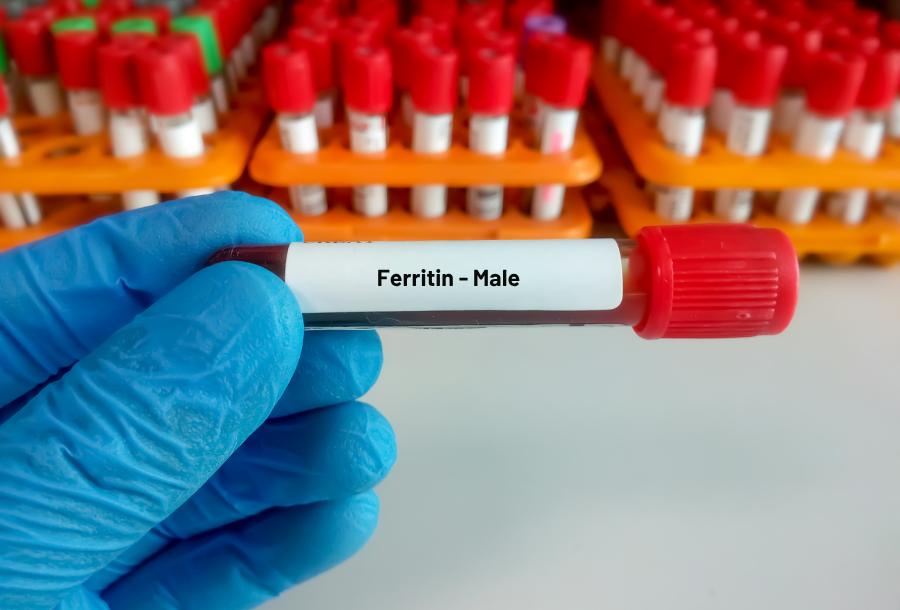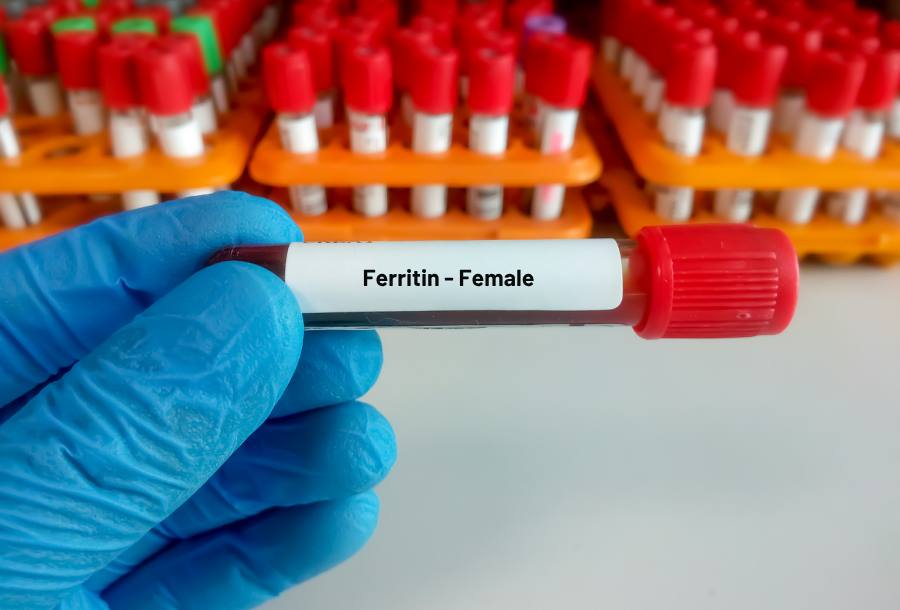Unlock Weight Loss With a Comprehensive Blood Test & Personalised Treatment Plan
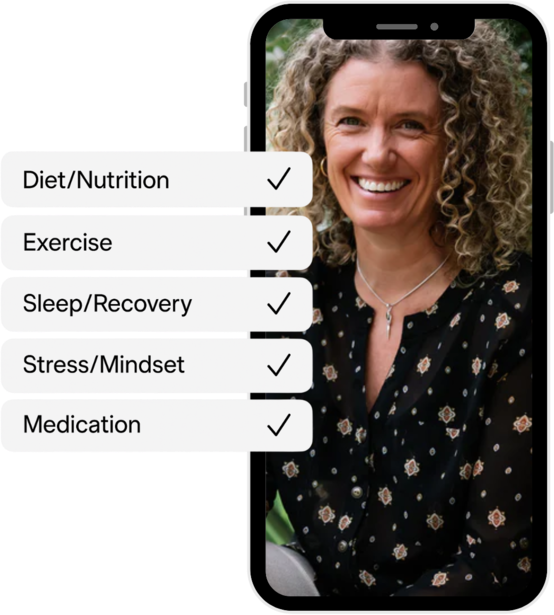
Only 50 spots left in September - reserve your spot now for free.

- Discover why your body is holding onto weight
- Get a doctor-led plan tailored to your biology, including medication if suitable
- 1:1 coaching to build habits that drive long-term sustainable weight loss
On this page
Haemoglobin is the oxygen-carrying protein found in red blood cells. It plays a key role in transporting oxygen from the lungs to the rest of the body, helping maintain energy, metabolism, and overall health. When Haemoglobin levels are too low, it may indicate anaemia, which can cause fatigue, shortness of breath, and reduced immunity.
On the other hand, high levels can occur due to smoking, dehydration, or certain heart and lung conditions. Monitoring Haemoglobin helps assess how well your body delivers oxygen and supports cellular function.
This guide explains what it is, how it works, what your results mean, and how you can book a comprehensive blood test to check your Haemoglobin.
What is Haemoglobin?
Haemoglobin is a protein inside your red blood cells that carries oxygen from your lungs to the rest of your body and returns carbon dioxide back to the lungs to be exhaled. Think of it like a delivery truck—Haemoglobin picks up oxygen “packages” in the lungs and drops them off where your body needs energy, such as your muscles and brain.
When Haemoglobin levels drop too low, your body doesn’t get enough oxygen, leading to tiredness, dizziness, and pale skin. High levels, meanwhile, may occur from dehydration, smoking, or living at high altitudes.
A Haemoglobin blood test measures the amount of this vital protein and helps doctors check for anaemia, dehydration, and other health conditions. It’s a key part of a complete blood count (CBC) and gives insight into your overall oxygen-carrying capacity and wellbeing.
Quick facts:
- Haemoglobin is made of iron and protein.
- Low levels may mean anaemia or blood loss.
- High levels can relate to dehydration or heart and lung problems.
Keeping your Haemoglobin within a healthy range supports energy, focus, and endurance. Regular blood tests can help track changes early, allowing you to address possible causes before they affect your daily health.
Why is Haemoglobin Important?
Haemoglobin is central to your health, metabolism, and longevity because it determines how efficiently your body transports oxygen—fuel for every cell—to tissues and organs. Adequate oxygen delivery supports metabolism, energy production, and repair processes; when haemoglobin levels fall too low or climb too high, these systems are strained.
Low haemoglobin (anaemia) is linked to chronic fatigue, weakened immunity, impaired cognitive function, and reduced exercise capacity. In pregnant women, iron-deficiency anaemia (which lowers haemoglobin) can raise risks for maternal and perinatal complications. Globally, nearly 1 in 4 people are affected by anaemia.
In Australia, about 22.3 % of women have depleted iron stores (a precursor to low haemoglobin), while anaemia affects around 15 % of premenopausal women and 8 % of young children in national data.
Conversely, excessively high haemoglobin can thicken blood, increasing strain on the heart and raising risks of cardiovascular events and mortality. Recent research shows a U-shaped link between haemoglobin levels and all-cause mortality—both low and high values associate with greater risk.
By keeping haemoglobin within healthy limits, you support your body’s metabolic efficiency, endurance, and long-term resilience.
When should you get a Haemoglobin test?
A Haemoglobin blood test is recommended when there are signs of oxygen or iron imbalance, or if your doctor suspects a condition affecting red blood cells. It’s a standard part of a complete blood count (CBC) but may also be done on its own to assess anaemia, dehydration, or chronic disease.
You may need a Haemoglobin test if you have:
- Symptoms such as tiredness, pale skin, dizziness, or shortness of breath.
- Low iron or ferritin levels, which can lead to anaemia.
- Chronic conditions like kidney disease, heart failure, or lung disorders.
- Heavy menstrual bleeding, recent blood loss, or frequent blood donation.
- Pregnancy, to monitor oxygen and iron levels for both mother and baby.
- Deficiencies in iron, folate, or vitamin B12 affecting red blood cell production.
- A GP referral for ongoing fatigue, weakness, or suspected anaemia.
Testing Haemoglobin alongside markers like Ferritin, Iron, Vitamin B12, and Haematocrit provides a fuller picture of your blood health and oxygen-carrying capacity.
How the Haemoglobin test works in Australia
In Australia, a Haemoglobin test is typically included as part of a full blood count (FBC) panel (also called “full blood examination”) under MBS item codes such as 65060 and 65070, which covers haemoglobin, red cell count, haematocrit, platelets, white cell count and indices.
Preparation: You do not need to fast for a haemoglobin or FBC test — you can eat and drink normally unless your doctor also requests tests that require fasting (e.g. lipid profile, glucose).
Medicare coverage vs private costs:
- Many pathology tests, including haemoglobin via a full blood count, are eligible for Medicare rebates when ordered by a GP for medical purposes.
- The schedule (“fee”) for these services is set in the Medicare Benefits Schedule (MBS). For example, the schedule fee for item 65060 (haemoglobin etc.) is $7.85 with Medicare benefits paying 75% (or 85% for concession card holders)
- However, pathology providers can charge a “gap fee” or out-of-pocket cost above the Medicare rebate, especially if the test is not bulk billed or falls outside the MBS criteria.
- Some private labs advertise “no gap” or bulk-billing for eligible tests, but this varies by location and provider.
Access via comprehensive blood panels:
- The haemoglobin test is often bundled in comprehensive panels (e.g. “full blood count”, “wellness panel”) along with Ferritin, Iron, Vitamin B12, and other biomarkers.
- Many digital health or direct access pathology services in Australia allow you to request such panels without a GP referral (though Medicare rebates typically require a GP’s request).
- Once your sample is collected (usually via a venous blood draw), results are processed in a pathology lab and sent back to your GP or directly (depending on the service).
By understanding the Medicare rebate structure, possible gap costs, and how comprehensive panels include haemoglobin, patients in Australia can better plan and access this test.
What do my results mean?
Your Haemoglobin test results show how much oxygen-carrying protein is present in your blood. Levels that fall outside the healthy range may suggest issues with oxygen delivery, iron status, or red blood cell production.
Below is a simple guide to understanding your Haemoglobin results:
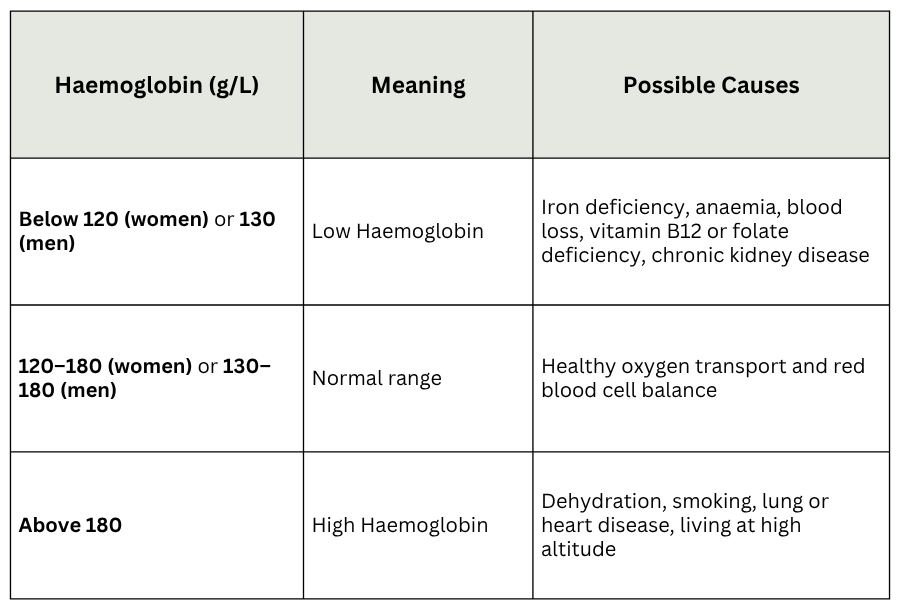
Low Haemoglobin is one of the most common signs of anaemia and may occur together with low Ferritin, Iron, or Haematocrit levels. High results may point to dehydration or conditions that increase red cell production.
If your results are outside the normal range, your doctor may recommend further testing to identify the cause and guide treatment or lifestyle changes.
Haemoglobin in context (other relevant tests)
A Haemoglobin result provides valuable insight into your blood’s ability to carry oxygen, but it becomes even more meaningful when viewed alongside other blood markers that influence red blood cell health. Interpreting these results together helps identify whether changes in Haemoglobin are due to iron deficiency, dehydration, or another underlying issue.
Key related tests include:
- Ferritin: Measures stored iron and helps confirm whether low Haemoglobin is caused by iron deficiency.
- Serum Iron: Shows how much circulating iron is available for red blood cell production.
- Haematocrit (HCT): Reflects the proportion of red blood cells in your blood, often moving in line with Haemoglobin.
- Vitamin B12 and Folate: Low levels can cause anaemia even when iron stores are normal.
Together, these tests give a more complete view of your blood and oxygen status, helping guide treatment, diet, or lifestyle adjustments to restore healthy balance.
Lifestyle and practical steps
Healthy Haemoglobin levels depend on a balance of nutrients, oxygen, and overall wellbeing. Several everyday habits can help support your red blood cell health and oxygen-carrying capacity naturally.
- Eat iron-rich foods: Include both heme iron (from red meat, chicken, and fish) and non-heme iron (from lentils, tofu, spinach, and fortified cereals). Pairing plant-based iron with vitamin C–rich foods like citrus or capsicum can improve absorption.
- Support with key nutrients: Folate, vitamin B12, and vitamin B6 are essential for red blood cell production. Good sources include leafy greens, eggs, beans, and whole grains.
- Stay hydrated: Proper hydration keeps your blood volume balanced and prevents falsely high Haemoglobin readings caused by dehydration.
- Exercise regularly: Moderate aerobic activity such as walking, cycling, or swimming enhances oxygen use and stimulates red blood cell formation over time.
- Prioritise rest and manage stress: Chronic stress and poor sleep can reduce oxygen efficiency and overall vitality. Aim for consistent sleep patterns and relaxation techniques like yoga or breathing exercises.
Making these habits part of your routine can help maintain optimal Haemoglobin levels and energy. The best starting point is testing — once you know your levels, you can take personalised steps.
FAQs about Haemoglobin Blood Test in Australia
What is a Haemoglobin blood test used for?
A Haemoglobin test measures the amount of oxygen-carrying protein in your red blood cells. It helps detect anaemia, dehydration, and other conditions affecting blood health and oxygen delivery throughout the body.
How much does a Haemoglobin test cost in Australia?
If ordered by your GP, a Haemoglobin test is usually bulk billed under Medicare. Without a referral, private pathology providers may charge between $20 and $50, depending on the clinic and location.
Is a referral needed for a Haemoglobin test?
Yes, a GP referral is generally required for Medicare coverage. However, some private labs and health platforms offer direct-access blood panels that include Haemoglobin without needing a referral.
Does Medicare cover Haemoglobin testing?
Yes. When requested by a GP as part of a full blood count (MBS item 65060 or 65070), Medicare typically covers the test, meaning most patients won’t pay out of pocket.
What are normal Haemoglobin levels?
The normal range is 130–180 g/L for men and 120–180 g/L for women. Results outside these ranges may indicate anaemia, dehydration, or a medical condition affecting red blood cell production.
Can Haemoglobin levels change during pregnancy?
Yes. Haemoglobin often drops slightly during pregnancy due to increased blood volume. Regular monitoring helps ensure healthy oxygen delivery for both mother and baby.
What symptoms suggest I should get a Haemoglobin test?
Common symptoms include tiredness, pale skin, dizziness, shortness of breath, or rapid heartbeat. These signs may point to low Haemoglobin or iron levels and should be discussed with your doctor.
Conclusion
Haemoglobin plays a vital role in keeping your body energised and functioning well. As the main oxygen-carrying protein in red blood cells, it ensures every cell receives the fuel it needs to perform daily tasks. When Haemoglobin levels are too low, symptoms like fatigue, pale skin, or shortness of breath can appear. High levels, on the other hand, may signal dehydration or issues affecting your lungs or heart.
Regular Haemoglobin testing offers valuable insight into your oxygen balance and overall health. Understanding your levels helps you make informed decisions about diet, lifestyle, and when to seek medical advice.
Empowering yourself with this knowledge is one of the best ways to stay proactive about your wellbeing. Take control of your health today. Sign up for our comprehensive blood test and get clear insights into your Haemoglobin and more than 50 other key markers.
References
Meet our team.
Subscribe to our newsletter & join a community of 20,000+ Aussies
Get access to limited content drops, free invites to expert fireside chats, and exclusive offers.
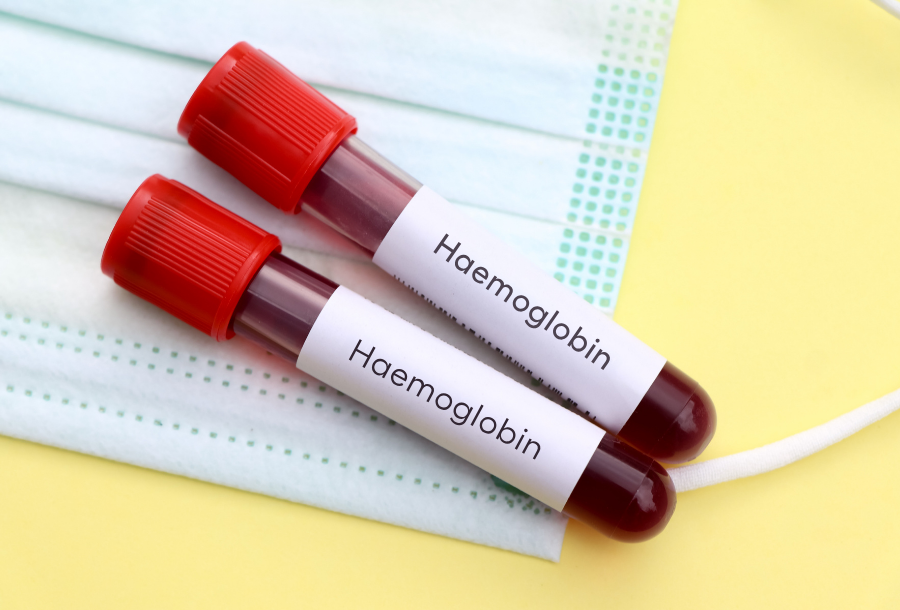
Haemoglobin blood test Australia | check your iron levels
Haemoglobin is the oxygen-carrying protein found in red blood cells. It plays a key role in transporting oxygen from the lungs to the rest of the body, helping maintain energy, metabolism, and overall health. When Haemoglobin levels are too low, it may indicate anaemia, which can cause fatigue, shortness of breath, and reduced immunity.
On the other hand, high levels can occur due to smoking, dehydration, or certain heart and lung conditions. Monitoring Haemoglobin helps assess how well your body delivers oxygen and supports cellular function.
This guide explains what it is, how it works, what your results mean, and how you can book a comprehensive blood test to check your Haemoglobin.
What is Haemoglobin?
Haemoglobin is a protein inside your red blood cells that carries oxygen from your lungs to the rest of your body and returns carbon dioxide back to the lungs to be exhaled. Think of it like a delivery truck—Haemoglobin picks up oxygen “packages” in the lungs and drops them off where your body needs energy, such as your muscles and brain.
When Haemoglobin levels drop too low, your body doesn’t get enough oxygen, leading to tiredness, dizziness, and pale skin. High levels, meanwhile, may occur from dehydration, smoking, or living at high altitudes.
A Haemoglobin blood test measures the amount of this vital protein and helps doctors check for anaemia, dehydration, and other health conditions. It’s a key part of a complete blood count (CBC) and gives insight into your overall oxygen-carrying capacity and wellbeing.
Quick facts:
- Haemoglobin is made of iron and protein.
- Low levels may mean anaemia or blood loss.
- High levels can relate to dehydration or heart and lung problems.
Keeping your Haemoglobin within a healthy range supports energy, focus, and endurance. Regular blood tests can help track changes early, allowing you to address possible causes before they affect your daily health.
Why is Haemoglobin Important?
Haemoglobin is central to your health, metabolism, and longevity because it determines how efficiently your body transports oxygen—fuel for every cell—to tissues and organs. Adequate oxygen delivery supports metabolism, energy production, and repair processes; when haemoglobin levels fall too low or climb too high, these systems are strained.
Low haemoglobin (anaemia) is linked to chronic fatigue, weakened immunity, impaired cognitive function, and reduced exercise capacity. In pregnant women, iron-deficiency anaemia (which lowers haemoglobin) can raise risks for maternal and perinatal complications. Globally, nearly 1 in 4 people are affected by anaemia.
In Australia, about 22.3 % of women have depleted iron stores (a precursor to low haemoglobin), while anaemia affects around 15 % of premenopausal women and 8 % of young children in national data.
Conversely, excessively high haemoglobin can thicken blood, increasing strain on the heart and raising risks of cardiovascular events and mortality. Recent research shows a U-shaped link between haemoglobin levels and all-cause mortality—both low and high values associate with greater risk.
By keeping haemoglobin within healthy limits, you support your body’s metabolic efficiency, endurance, and long-term resilience.
When should you get a Haemoglobin test?
A Haemoglobin blood test is recommended when there are signs of oxygen or iron imbalance, or if your doctor suspects a condition affecting red blood cells. It’s a standard part of a complete blood count (CBC) but may also be done on its own to assess anaemia, dehydration, or chronic disease.
You may need a Haemoglobin test if you have:
- Symptoms such as tiredness, pale skin, dizziness, or shortness of breath.
- Low iron or ferritin levels, which can lead to anaemia.
- Chronic conditions like kidney disease, heart failure, or lung disorders.
- Heavy menstrual bleeding, recent blood loss, or frequent blood donation.
- Pregnancy, to monitor oxygen and iron levels for both mother and baby.
- Deficiencies in iron, folate, or vitamin B12 affecting red blood cell production.
- A GP referral for ongoing fatigue, weakness, or suspected anaemia.
Testing Haemoglobin alongside markers like Ferritin, Iron, Vitamin B12, and Haematocrit provides a fuller picture of your blood health and oxygen-carrying capacity.
How the Haemoglobin test works in Australia
In Australia, a Haemoglobin test is typically included as part of a full blood count (FBC) panel (also called “full blood examination”) under MBS item codes such as 65060 and 65070, which covers haemoglobin, red cell count, haematocrit, platelets, white cell count and indices.
Preparation: You do not need to fast for a haemoglobin or FBC test — you can eat and drink normally unless your doctor also requests tests that require fasting (e.g. lipid profile, glucose).
Medicare coverage vs private costs:
- Many pathology tests, including haemoglobin via a full blood count, are eligible for Medicare rebates when ordered by a GP for medical purposes.
- The schedule (“fee”) for these services is set in the Medicare Benefits Schedule (MBS). For example, the schedule fee for item 65060 (haemoglobin etc.) is $7.85 with Medicare benefits paying 75% (or 85% for concession card holders)
- However, pathology providers can charge a “gap fee” or out-of-pocket cost above the Medicare rebate, especially if the test is not bulk billed or falls outside the MBS criteria.
- Some private labs advertise “no gap” or bulk-billing for eligible tests, but this varies by location and provider.
Access via comprehensive blood panels:
- The haemoglobin test is often bundled in comprehensive panels (e.g. “full blood count”, “wellness panel”) along with Ferritin, Iron, Vitamin B12, and other biomarkers.
- Many digital health or direct access pathology services in Australia allow you to request such panels without a GP referral (though Medicare rebates typically require a GP’s request).
- Once your sample is collected (usually via a venous blood draw), results are processed in a pathology lab and sent back to your GP or directly (depending on the service).
By understanding the Medicare rebate structure, possible gap costs, and how comprehensive panels include haemoglobin, patients in Australia can better plan and access this test.
What do my results mean?
Your Haemoglobin test results show how much oxygen-carrying protein is present in your blood. Levels that fall outside the healthy range may suggest issues with oxygen delivery, iron status, or red blood cell production.
Below is a simple guide to understanding your Haemoglobin results:

Low Haemoglobin is one of the most common signs of anaemia and may occur together with low Ferritin, Iron, or Haematocrit levels. High results may point to dehydration or conditions that increase red cell production.
If your results are outside the normal range, your doctor may recommend further testing to identify the cause and guide treatment or lifestyle changes.
Haemoglobin in context (other relevant tests)
A Haemoglobin result provides valuable insight into your blood’s ability to carry oxygen, but it becomes even more meaningful when viewed alongside other blood markers that influence red blood cell health. Interpreting these results together helps identify whether changes in Haemoglobin are due to iron deficiency, dehydration, or another underlying issue.
Key related tests include:
- Ferritin: Measures stored iron and helps confirm whether low Haemoglobin is caused by iron deficiency.
- Serum Iron: Shows how much circulating iron is available for red blood cell production.
- Haematocrit (HCT): Reflects the proportion of red blood cells in your blood, often moving in line with Haemoglobin.
- Vitamin B12 and Folate: Low levels can cause anaemia even when iron stores are normal.
Together, these tests give a more complete view of your blood and oxygen status, helping guide treatment, diet, or lifestyle adjustments to restore healthy balance.
Lifestyle and practical steps
Healthy Haemoglobin levels depend on a balance of nutrients, oxygen, and overall wellbeing. Several everyday habits can help support your red blood cell health and oxygen-carrying capacity naturally.
- Eat iron-rich foods: Include both heme iron (from red meat, chicken, and fish) and non-heme iron (from lentils, tofu, spinach, and fortified cereals). Pairing plant-based iron with vitamin C–rich foods like citrus or capsicum can improve absorption.
- Support with key nutrients: Folate, vitamin B12, and vitamin B6 are essential for red blood cell production. Good sources include leafy greens, eggs, beans, and whole grains.
- Stay hydrated: Proper hydration keeps your blood volume balanced and prevents falsely high Haemoglobin readings caused by dehydration.
- Exercise regularly: Moderate aerobic activity such as walking, cycling, or swimming enhances oxygen use and stimulates red blood cell formation over time.
- Prioritise rest and manage stress: Chronic stress and poor sleep can reduce oxygen efficiency and overall vitality. Aim for consistent sleep patterns and relaxation techniques like yoga or breathing exercises.
Making these habits part of your routine can help maintain optimal Haemoglobin levels and energy. The best starting point is testing — once you know your levels, you can take personalised steps.
FAQs about Haemoglobin Blood Test in Australia
What is a Haemoglobin blood test used for?
A Haemoglobin test measures the amount of oxygen-carrying protein in your red blood cells. It helps detect anaemia, dehydration, and other conditions affecting blood health and oxygen delivery throughout the body.
How much does a Haemoglobin test cost in Australia?
If ordered by your GP, a Haemoglobin test is usually bulk billed under Medicare. Without a referral, private pathology providers may charge between $20 and $50, depending on the clinic and location.
Is a referral needed for a Haemoglobin test?
Yes, a GP referral is generally required for Medicare coverage. However, some private labs and health platforms offer direct-access blood panels that include Haemoglobin without needing a referral.
Does Medicare cover Haemoglobin testing?
Yes. When requested by a GP as part of a full blood count (MBS item 65060 or 65070), Medicare typically covers the test, meaning most patients won’t pay out of pocket.
What are normal Haemoglobin levels?
The normal range is 130–180 g/L for men and 120–180 g/L for women. Results outside these ranges may indicate anaemia, dehydration, or a medical condition affecting red blood cell production.
Can Haemoglobin levels change during pregnancy?
Yes. Haemoglobin often drops slightly during pregnancy due to increased blood volume. Regular monitoring helps ensure healthy oxygen delivery for both mother and baby.
What symptoms suggest I should get a Haemoglobin test?
Common symptoms include tiredness, pale skin, dizziness, shortness of breath, or rapid heartbeat. These signs may point to low Haemoglobin or iron levels and should be discussed with your doctor.
Conclusion
Haemoglobin plays a vital role in keeping your body energised and functioning well. As the main oxygen-carrying protein in red blood cells, it ensures every cell receives the fuel it needs to perform daily tasks. When Haemoglobin levels are too low, symptoms like fatigue, pale skin, or shortness of breath can appear. High levels, on the other hand, may signal dehydration or issues affecting your lungs or heart.
Regular Haemoglobin testing offers valuable insight into your oxygen balance and overall health. Understanding your levels helps you make informed decisions about diet, lifestyle, and when to seek medical advice.
Empowering yourself with this knowledge is one of the best ways to stay proactive about your wellbeing. Take control of your health today. Sign up for our comprehensive blood test and get clear insights into your Haemoglobin and more than 50 other key markers.
References
Get irrefutable data about your diet and lifestyle by using your own glucose data with Vively’s CGM Program. We’re currently offering a 20% discount for our annual plan. Sign up here.
Next articles

The link between glucose levels and ageing gracefully
Discover how controlling your glucose levels can aid in ageing gracefully. Learn about the latest research that links glucose levels and ageing, and how Vively, a metabolic health app, can help you manage your glucose and age well.


Mindful eating and its impact on glucose control
Delve into the concept of mindful eating and discover its benefits, including improved glucose control and healthier food choices. Learn about practical strategies to implement mindful eating in your daily life.


How to get tested for PCOS in Australia: A Comprehensive Guide
Understand the nuances of polycystic ovary syndrome (PCOS) testing in Australia, the importance of early diagnosis, and the tests used to effectively diagnose the condition. Also, find out when these diagnostic procedures should be considered.



 Share
Share Tweet
Tweet Share
Share






.png)


